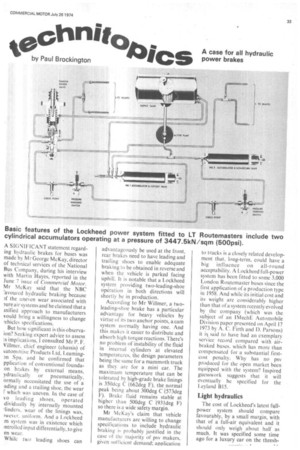Basic features of the Lockheed power system fitted to IT
Page 39

Page 40

If you've noticed an error in this article please click here to report it so we can fix it.
Routemasters include two cylindrical accumulators operating at a pressure of 3447.5kN/sqm (500psi).
A SIGNIFICANT statement regarding hydraulic brakes for buses was made by M r George McKay, director of technical services of the National Bus Company, during his interview with Martin Hayes, reported in the June 7 issue of Commercial Motor. Mr McKay said that the NBC 7avoured hydraulic braking because )1the uneven wear associated with )ure air systems and he claimed that a mified approach to manufacturers vould bring a willingness to change lehicles specifications.
But how significant is this observaion? Seeking expert advice to assess ts implications, I consulted Mr P. F. Villmer. chief engineer (chassis) of utomotive Products Ltd, Learning)n Spa, and he confirmed that pplication of conventional foundaon brakes by external means. ydraulically or pneumatically, ormally necessitated the use of a • ading and a trailing shoe, the wear I' which was uneven. In the case of vo leading shoes, operated dividually by internally mounted 'finders, wear of the linings was, )wevs.J. uniform.. And a Lockheed .m system was in existence which introlled input differentially, to give en wear.
While two leading shoes can advantageously be used at the front, rear brakes need to have leading and trailing shoes to enable adequate braking to be obtained in reverse and when the vehicle is parked facing uphill. It is notable that a Lockheed system providing two-leading-shoe operation in both directions will shortly be in production.
According to Mr Willmer, a twoleading-shoe brake has a _particular advantage for heavy vehicles by virtue of its two anchor points, a cam system normally having one. And this makes it easier to distribute and absorb high torque reactions. There's no problem of instability of the fluid in internal cylinders at elevated temperatures, the design parameters being the same for a mammoth truck as they are for a mini car. The maximum temperature that can be tolerated by high-grade brake linings is 350dcg C .(662deg F), the normal peak being about 300deg C (573deg F). Brake fluid remains stable at higher than 500deg C '(93 !deg F) so there is a wide safety margin.
Mr McKay's claim that vehicle manufacturers are willing to change specifications to include hydraulic braking is probably justified in the case of the majority of psv makers, given stilTicient demand.; application to trucks is a closely related development that, long-term, could have a big influence on all-round acceptability. A Lockheed full-power system has been fitted to some 3,000 London Routemaster buses since the first application of a production type in 1958. And while its initial cost and its weight are considerably higher than that of a system recently evolved by the company (which was the subject of an IMechE Automobile Division paper presented on April 17 1973 by A. C. Firth and D. Parsons) it i said to have had an exemplary service record compared with airbraked buses, which has more than compensated for a substantial firstcost penalty. Why has no psv produced for the open market been equipped with the system? Inspired guesswork suggests that it will eventually be specified for the Leyland B15.
Light hydraulics
The cost of Lockheed's latest ft411power system should compare favourably, by a small margin, with that of a full-air equivalent and it should only weigh ,about half as much. It was specified some time ago for a luxury car on the thresh old of production but the model was dropped because of its basic similarity to a new car in the company's range.
While current systems of each type are suitable for gvws up to 14.73 tonnes (14.5 tons), future developments should provide for applications to axles with the highest weight likely to be approved in Europe. The only unfavourable comparison that can be made with a full air system is that a leakage of fluid is more serious than a leakage of air, but the disadvantage is minimised by the use of a divided-line circuit and, as pointed out by Mr Willmer, a leak of air from a pneumatic pipe results in compressor over-loading and the ingress of moisture.
Important low-cost, low-weight features of the latest Lockheed system include twin spherical steel accumulators mounted on each side of the main valve block. Diaphragms are located in the inner hemispherical sections of the shells and are sealed after being charged with nitrogen at 4137 kN/scim .(600psi). In the case of the Routemaster system, power is provided by two separated cylindrical accumulators operating at a pressure of 3,447 kN; sqm (500 psi) each of which basically comprises a tube and a floating openended piston-separator which moves outward in the tube when the cylinder is charged with fluid to compress the air in the opposite end, compression being limited by contact of the open end of the piston with the cap assembly.
Compatibility problem
Two deterrents may he cited to the application of full-power hydraulic braking across the board to heavier trucks, apart from the nonavailability at present of systems for the heaviest vehicles. As mentioned by Mr W. V. Batstone. deputy chief engineer of the National Freight Corporation, in the discussion of the 1M echE paper, 90 per cent of heavier vehicles are artics, and the compatibility of hydraulically-braked tractive units with air-braked semitrailers is essential pending all-round application of hydraulics. And while Mr E. Dunn of the DoE observed in the discussion that UK regulations and the EEC Braking Directive would be unlikely to specify anti-lock brakes in the near future, the prospect exists of anti-lock taking on in a big way. with or without legislative backing, and this confuses forecasts of the future acceptability ..f
































































































